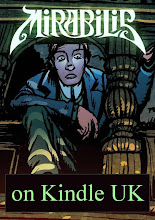“You naughty children,” she says. “I was having a nap after my journey and I suppose you put me in here like somebody’s lost steamer trunk?” When the children protest, she tells them never to talk back to an adult. Thus the Nurse Twicely books start as they go on, hammering home the suffocating manners of middle-class Edwardian England. But if that’s all the stories amounted to, they would not have been likely to seize the imagination of a generation of children. Mrs Barltrop was canny enough to include a hint of something fantastic as well:
“Why were you wrapped up in bandages?” said Annabel. “If you don’t mind me asking, miss.”The first book was published in 1924 and was followed by Nurse Twicely Returns and A Third Spoonful of Nurse Twicely. Her return in the second book (she arrives wrapped in brown paper having been posted from Timbuktu where she had gone to help the missionaries) gives a reason for her name: “Because I will give naughty children a second chance, you see, but only Our Lord can give you three chances, and after that you can whistle all you like about your hot toes but there’ll be no help for it.”
“It’s not miss, it’s nurse,” said Nurse Twicely. “And they aren’t bandages like those horrid Gyptians who hounded Moses used to use. This is holy lint, and wrapping myself in it has given me as much get-up-and-go as a dozen tonics and fifty spoons of castor oil.”
With that, she gathered up all the strips of fabric and smartly wrapped them into rolls, just as fast as cook could whip an egg. Binky gave a little growl as she tugged the last piece out of his mouth, but she wagged a short thick finger at him and he went as quiet as a wound-down clock, just like that. Then she packed roll after roll of bandages into her battered black bag. And there had been miles and miles of them, enough to stretch between every tree on the village green and still have enough to string the maypole, but she packed them all away in there like a conjurer doing a trick backwards.
“Now then,” she said, snapping shut the big brass clasp and taking up her bag. “I can see four growing children, and somebody mentioned castor oil.”
At the end of the second book she climbs into her Prophecy Box and announces that she will only visit again when Shiloh (the Panacea Society’s female saviour) has come for watercress sandwiches on the lawn. This presented problems when the success of the series meant that Mrs Barltrop’s publishers demanded the third book for which she had contracted, so the stories in the new volume were explained away as some adventures from Nurse Twicely’s other two visits to the Hallivancy household that she had forgotten to mention earlier. (It is surprising that Mrs Barltrop was confounded by the need for consistency given that, in the course of the books, the Hallivancy children go from being orphans to having a mother whose eye colour changes twice and a father who is either dead, in India on business, or the local clergyman.)
Some elements are established in these three books that are present in Nurse Twicely’s later incarnations. She wears a white linen hat “shaped like a scone”, she is best friends with twenty-four bishops, she has an even lower opinion of little boys than she does of little girls, she likes cats but not dogs, and she takes her charges on whirlwind adventures around the world. In the books her adventures are rather pedestrian, despite the exotic locations and fanciful (or ignorant) depictions of native characters. Her motivation for these trips seems to be only to take the healing lint to sick children who have sent her postcards. Her relationship with the Hallivancy children remains that of an admonishing martinet enforcing “nice” manners. But all that was to change…
By 1930, in order to retain its charitable status, the Panacea Society was obliged to shed some of its assets. Mrs Barltrop sold the rights in the Nurse Twicely books to the West End impresario Norton Dudley. He apparently never read the books, buying the rights on the advice of his eight-year-old nephew, and promptly decided they were ripe for theatrical adaptation. For this purpose he engaged twin writers Jonas and Ruta Dauksa, Lithuanian Jews whose experimental plays had been strongly influenced by Artaud’s surrealistic Theatre of Cruelty. To Nurse Twicely’s adventures the Dauksas brought an element of uncontrolled fabulosity, much of it probably deriving from their poor command of English. A flavour of this may be detected in the different ways they have Nurse Twicely convey the children on adventures:
- Setting sail in the boat at the bottom of the garden
- Taking off in a flying lawnmower piloted by the gardener
- Being carried along in the “plodding shed”
- Sitting on deckchairs in the mist
- Following the Rubric Footpath
- Taking a “quirkular” route through a cornfield (“Why, it’s a maize.”)
- Going out along the Dizza Pier, which sinks beneath the waves
McFeely composed a number of songs including “Jar-daft and Wobbly Wise”, “Poor Mr Butterhead”, “Black Magic and Fairycakes”, “Cardboardilly Boxadally”, “Socks for Tea”, “The Trouble with Tuesdays”, “Penguin Pie”, and “Riffraff and Sundry”. It should be no surprise to the reader to learn that McFeely had acquired a drug habit while in prison and fuelled his creative sessions with a cocktail of brandy, gin, betel leaf juice, and various narcotics.
The stage play enjoyed only moderate success and, as the generation that grew up with her turned to face the exigencies of the day, Nurse Twicely might have been forgotten. But in 1940 Norton Dudley, in an excess of patriotic zeal brought on by a health scare, donated the film rights to the Ministry of Information. “It shows the pride and ingenuity of the Semitic peoples in the face of adversity,” he declared, having forgotten the books ever existed or that Nurse Twicely, even in the Dauksas’ version, rarely allowed a scene to pass by without a dose of Biblical sanctimony.
That was swept away for the 1943 movie starring Arthur Askey. The script as rewritten by Marriott Edgar dispensed with Nurse Twicely’s smothering piety and made the whole story funnier and faster-paced, though at the expense of losing some of the fanciful charm the Dauksas had brought to it. Naturally Askey could not be repressed from improvising his trademark style of broad comedy patter with lines like, “Have you got the lint?” “Steady on, it’s just a touch of gout,” and the catchphrase, “That’ll do nicely, Twicely.” Some of the dialogue was deemed too risqué for wartime audiences, and ministry officials imposed a sound of crashing waves over the soundtrack as the Dizza Pier submerged:
NURSE: My old friend Dizzy? We called her Dizzy Peer on account of her bins. Like bottles, they were. Only you wouldn’t get a ha’pence if you took those back.The Rubric Footpath, which in the books was signposted with tendentious homilies and in the Dauksa play with koan-like riddles, here becomes the Rubberbrick Footpath, which Askey is able to bounce along with the help of some early wire work.
BISHOP: I didn’t say Dizzy. I said this is the Dizza Pier. It goes down, you see.
NURSE: So did Dizzy for two bob and a jam sandwich.
The episode in which Dolly Hallavancy is taken to the dentist illustrates the evolution of the concept. In Mrs Barltrop’s novel, Dolly is told to pull herself together, that the power of prayer is much more effective than any anaesthetic, and that Jesus endured much worse than toothache without complaint. In the play, the dentist has run out of laughing gas so he gives Dolly sneezing gas instead. It was left to Marriott Edgar to turn this into a full-blown comedy set-piece. In place of laughing gas, Dolly is offered a range of substitutes: “Sneezing gas, burping gas, hiccup gas. This one… oh, that just gives you gas.” Opting for blurting gas, Dolly then finds she cannot keep a secret or tell a lie, causing mayhem in the Hallavancy household until Nurse Twicely counteracts the outbreak of honesty with a gobstopper. Yet it’s possible that Mr Edgar may have drawn inspiration for this scene from the novel, where the character is known as the Gossiping Dentist and reveals all sorts of indiscretions. In the play this has become the Gossipy Dentures, an amusing puppet character who lives in a glass of water and generates chaos with his acerbic Loki-like pronouncements. (In the movie, the Gossipy Dentures appear only briefly and are voiced by Will Hay.)
Other characters that appear in various incarnations in either book, play, movie, or all three include the Garden Metro-gnome, Bad Dog and Wise Cat, and Dr Hugh, the twenty-fourth bishop who helps rescue the other twenty-three after they have fallen through the Prophecy Box into another world (an obvious lift from E Nesbit’s short story, “The Aunt and Amabel”).
After the war, with the books out of print and cinemas eager to replace British pictures with imported Hollywood features, the character of Nurse Twicely lapsed into obscurity. It’s possible that a young Spike Milligan may have come across the play while entertaining the troops in his artillery unit as part of the First Army in North Africa. Could Mabel Barltrop’s hectoring creation have influenced the anarchic comedy of the Goons? The truth, as ever, is unknowable.

























There was actually an earlier film version (1939) starring German comedienne Pirla Olof, who was a protege of Fritz Lang. World War 2 scotched the release as a Nazi leading lady was box-office disaster. Eva Braun was reputedly a big fan of Olof, and it is rumoured that she and Hitler watched a series of Olof films in the Furher Bunker the night before their suicides. Perhaps Twicely drove them to it?
ReplyDeleteA seminal moment in history. I bet the Führer was sitting there saying, "You know, Eva, it's a shame the war is a bust, but I could still go back to painting." And then he watched the Olof movies and five minutes later he was reaching for his Luger.
Delete